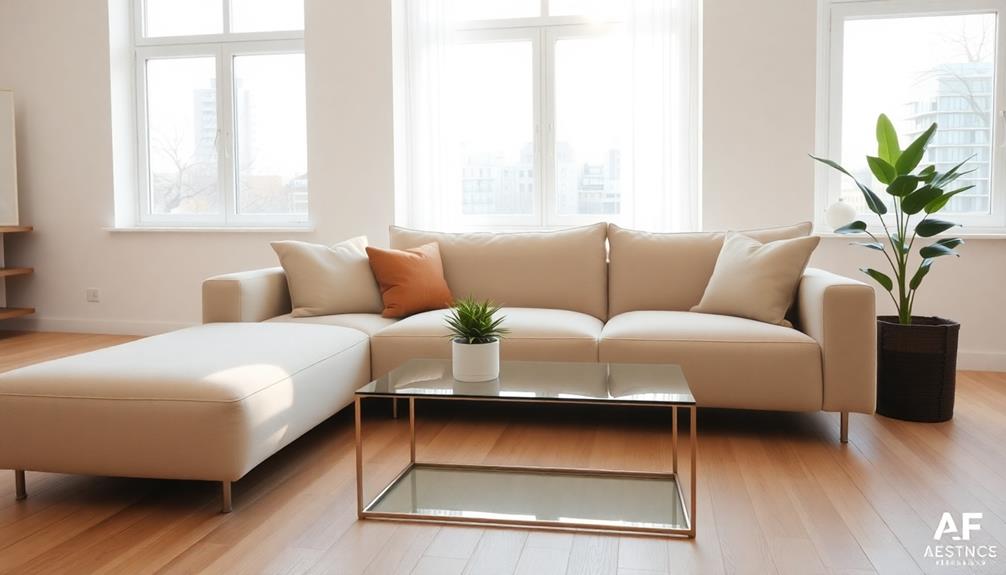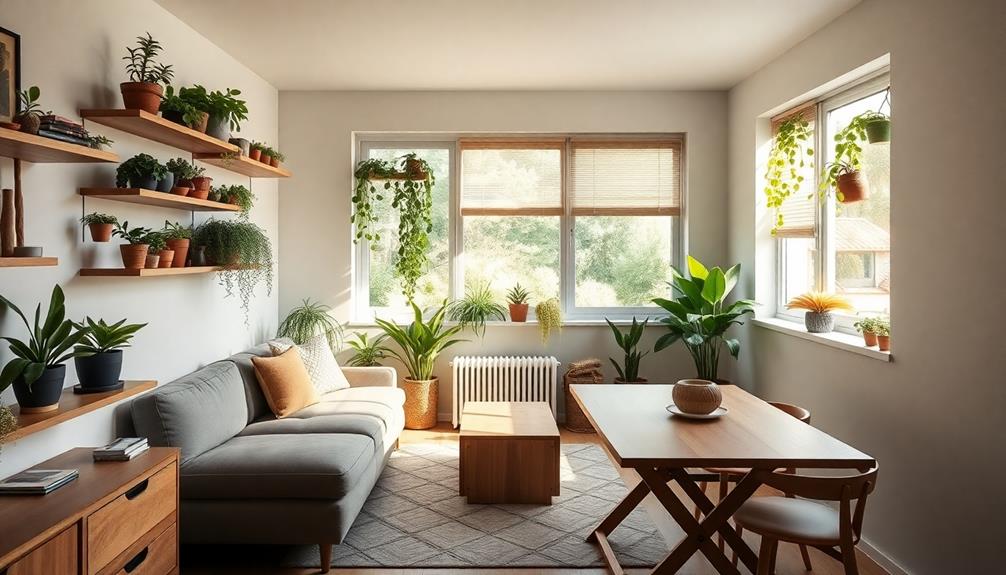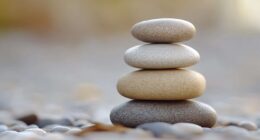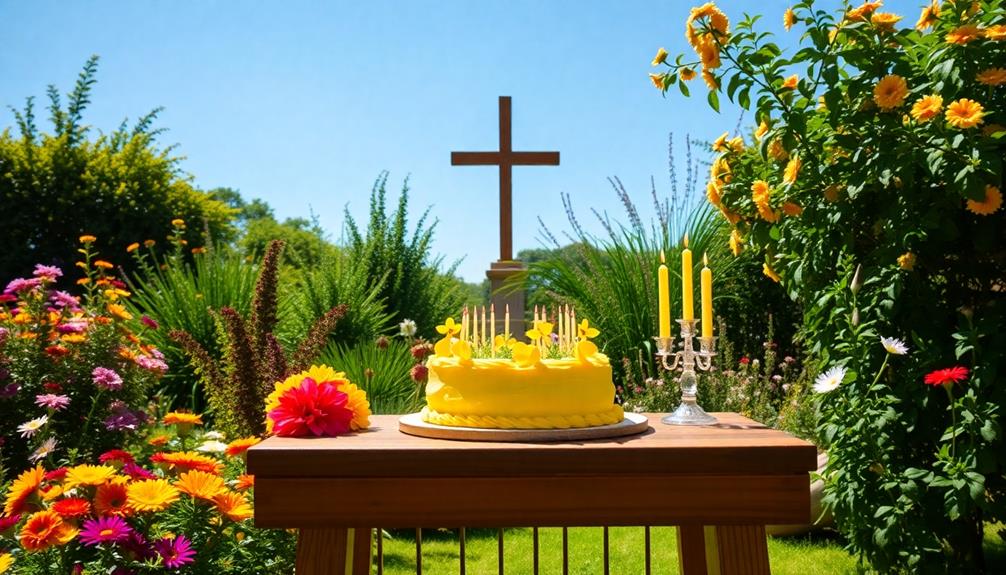Discovering the power of minimalist interior decor can transform your space into a serene retreat. You'll find that simplicity and functionality reign, allowing you to focus on what truly matters. By choosing natural materials and a neutral color palette, you create a calming environment that reduces clutter and stress. Minimalism promotes intentional living, so you'll choose quality over quantity, maximizing utility without sacrificing aesthetics. This approach not only enhances your home's beauty but also supports sustainable practices. If you want to uncover more ways to embrace minimalism in your decor, there's plenty to explore further.
Key Takeaways
- Minimalist decor emphasizes simplicity and functionality, creating serene living spaces that promote calmness and order.
- Utilizing high-quality, natural materials enhances aesthetics while fostering a connection to nature and sustainability.
- Multi-functional furniture maximizes utility, reducing clutter and adapting to various living needs seamlessly.
- A neutral color palette fosters a cohesive aesthetic, allowing personal touches to stand out without overwhelming the space.
- Minimalism reduces visual clutter, leading to lower stress levels, improved focus, and enhanced overall well-being.
Understanding Minimalism
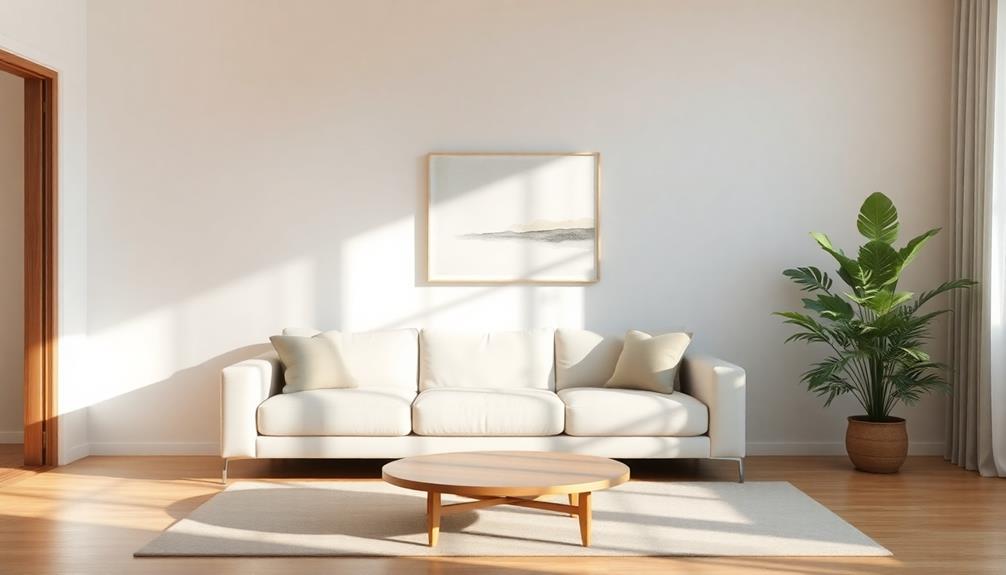
Minimalism is all about embracing simplicity and functionality in your space. When you adopt a minimalist approach, you focus on the essential elements that bring value to your life while eliminating clutter and distractions.
This philosophy, rooted in the 20th century, encourages you to be intentional about your possessions and surroundings. Additionally, incorporating natural materials, as seen in Balinese design concepts, can enhance the minimalist aesthetic by promoting a connection to nature.
In minimalist interior design, you'll find that neutral colors play a significant role. These calming hues create a serene environment, allowing you to appreciate the beauty in simplicity.
Key Principles of Minimalist Design
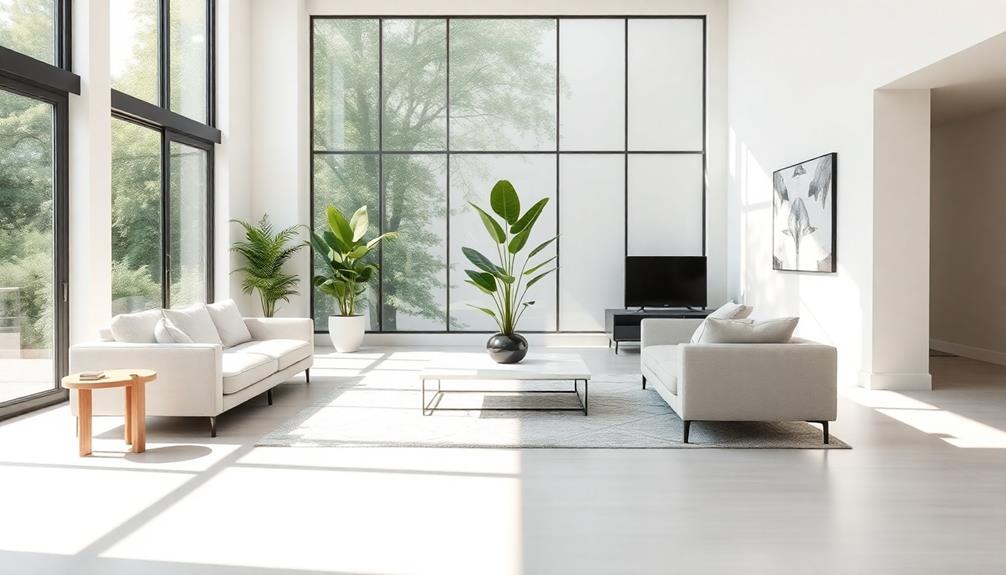
Embracing the key principles of minimalist design allows you to create spaces that are both functional and aesthetically pleasing. At the heart of minimalist design is the idea of "less is more," where you focus on simplicity and functionality. This means incorporating only essential elements into your space while eliminating excess that doesn't serve a purpose.
By integrating natural materials reminiscent of traditional Indonesian style decor, you can enhance the serenity and warmth of your minimalist space.
Utilizing neutral color palettes, such as whites, grays, and earth tones, helps create a serene environment that fosters a calming atmosphere. Each item you choose should have functionality and purpose, promoting efficiency through the use of multifunctional furniture. By doing this, you not only enhance the aesthetic but also reduce mental clutter.
Another key principle is the emphasis on quality over quantity. Investing in high-quality materials and timeless design choices not only supports sustainability but also guarantees that your space remains stylish for years.
Psychological Benefits of Minimalism

Creating a minimalist interior doesn't just enhance the space visually; it also brings significant psychological benefits. By embracing minimalism, you can reduce clutter and chaos, which lowers stress levels and improves your mental health. The simplicity and orderliness of your environment foster a sense of calm, allowing you to focus on your thoughts and activities without distractions.
Research shows that individuals living in minimalist spaces often report higher satisfaction and well-being. This intentional living encourages creativity and productivity, as uncluttered spaces enhance your cognitive function. You'll find it easier to solve problems and make decisions when your surroundings are simplified.
Here's a quick overview of the psychological benefits of minimalism:
| Benefit | Description |
|---|---|
| Reduced Stress | Lower visual clutter leads to decreased anxiety. |
| Enhanced Focus | Simplicity helps you concentrate better. |
| Increased Creativity | Clear spaces promote creative thinking. |
| Improved Decision-Making | Simplified environments aid cognitive function. |
| Greater Satisfaction | Orderliness contributes to overall well-being. |
Sustainability in Minimalist Decor

Sustainable living often goes hand in hand with minimalist decor, as both prioritize thoughtful choices that benefit the environment. Embracing minimalist design encourages you to focus on high-quality items that last longer, reducing the need for frequent replacements and minimizing waste.
By incorporating elements of Indonesian decorative pillows, you not only enhance your space with vibrant colors and patterns but also support traditional craftsmanship. By investing in durable materials, you not only enhance your space but also contribute to a more sustainable future.
Moreover, minimalist decor promotes intentional living, urging you to make mindful purchasing decisions. This means choosing fewer, multifunctional pieces that serve multiple purposes, which helps streamline your home while consuming fewer resources.
Instead of filling your space with numerous items, you can create a harmonious environment with versatile furniture that adapts to your lifestyle.
Decluttering is another key aspect of minimalism that considerably helps reduce waste. By donating or recycling items you no longer need, you contribute to a more sustainable cycle of consumption.
Additionally, many minimalist designs incorporate natural materials like wood and stone, which are more eco-friendly options compared to synthetic alternatives.
Flexibility and Adaptability in Spaces

In minimalist interior decor, you can embrace versatility by utilizing multi-functional furniture that adapts to your needs.
Incorporating functional furniture enhances both play and relaxation, making it ideal for families.
Whether you're transforming a guest room into an office or rearranging your living space for a gathering, the options are endless.
Plus, with easy design updates, keeping your space fresh and inviting requires minimal effort.
Versatile Space Utilization
Minimalist interior decor really shines when it comes to versatile space utilization, effortlessly altering rooms to meet your changing needs. By embracing minimalist interiors, you can create spaces that serve multiple functions, such as combining a guest room with a home office. This enhances your overall livability, allowing you to adapt to varying circumstances.
The principles of traditional design can also inspire minimalist approaches, emphasizing the significance of materials and a harmonious color palette. Neutral backdrops in these designs facilitate quick adaptations, letting you refresh your space without significant renovations.
You'll find that multi-functional furniture, like sofas with hidden storage or extendable dining tables, maximizes utility while minimizing clutter. This approach supports efficient use of limited space.
Open floor plans play a vital role in creating flexible environments, making it easy to rearrange furniture for different activities or gatherings. Incorporating intentional design elements, such as movable partitions, enables seamless shifts between various uses of a space.
These thoughtful choices enhance adaptability, ensuring your home remains functional and inviting, no matter what the day brings. Incorporating these strategies into your decor not only enhances versatility but also fosters a sense of calm and order, making minimalist design a truly powerful choice for modern living.
Multi-Functional Furniture Options
When you embrace multi-functional furniture, you're not just saving space; you're enhancing the versatility of your home.
These innovative pieces, like sofas with hidden storage and extendable dining tables, maximize utility in minimalist spaces, allowing rooms to serve multiple purposes without the clutter and excess of traditional furnishings.
By incorporating high-quality materials sourced locally, as seen in luxury tropical designs, you can elevate your minimalist aesthetic while maintaining functionality.
Incorporating modular furniture enables you to easily adapt your environment for various needs, transforming a living room into a guest space with minimal effort.
High-quality, versatile pieces such as ottomans that double as seating or coffee tables with storage further streamline your living area, reducing the number of items you need while boosting functionality.
Easy Design Updates
Updating your interior design can be a breeze with a minimalist approach, as the simplicity of neutral backdrops allows for effortless changes. With a limited color palette, you can easily switch up decor items to reflect your mood or the season.
Flexible layouts, like open floor plans, let you adapt spaces for multiple functions. For instance, that home office can transform into a guest room in no time. This adaptability is similar to the principles found in tropical villa plans, where open spaces and natural light create a serene atmosphere.
Minimalist design emphasizes negative space, preventing overcrowding and chaos, which makes it simple to adjust a room's purpose. When you utilize modular or multi-functional furniture, you gain even more versatility.
You can rearrange your furniture to suit different activities or repurpose pieces as your needs evolve. The clean lines inherent in minimalist design contribute to this adaptability, allowing new elements to blend seamlessly into your existing decor.
Practical Decluttering Techniques

To create a serene and organized living space, start your decluttering journey by evaluating each room and identifying items that don't bring you joy or serve a purpose.
Embracing minimalism means you should focus on keeping only what truly enhances your life. Consider incorporating sustainable home decor materials to further enhance your minimalist approach while being eco-friendly.
Here are some practical decluttering techniques to help you:
- Implement the "one in, one out" rule to maintain balance; for every new item, remove an old one.
- Schedule regular decluttering sessions, like once a month, to reassess your belongings and prevent clutter accumulation.
- Utilize multifunctional furniture with built-in storage solutions to keep essential items organized while enhancing your aesthetic appeal.
- Donate or recycle unused items to promote sustainability and support your community.
- Create designated spaces for each category of items, making it easier to identify what's truly necessary.
Creating a Cohesive Aesthetic
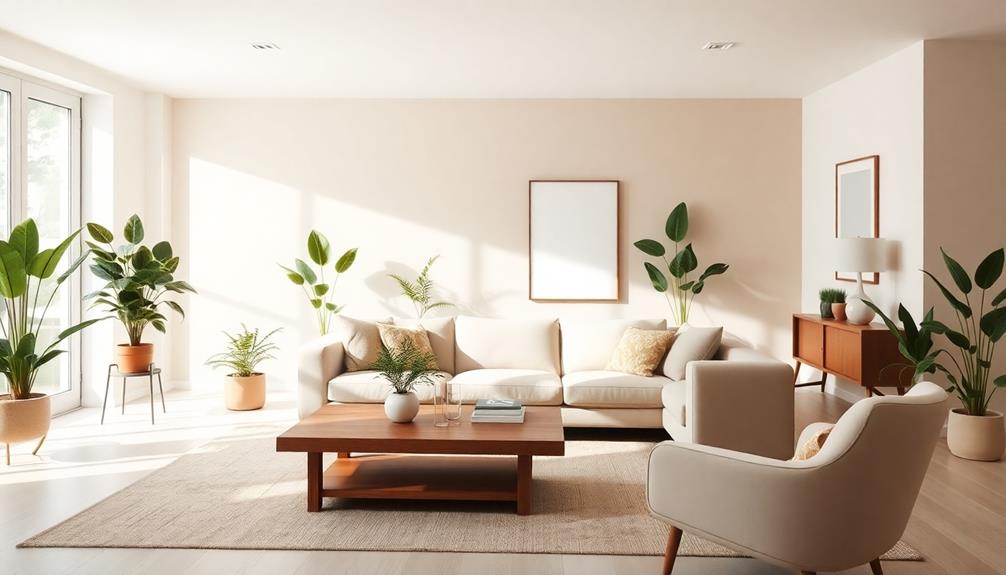
Creating a cohesive aesthetic in your minimalist interior involves intentional choices that promote a sense of tranquility and harmony. Embrace minimalism by opting for a limited color palette, focusing primarily on neutral tones like whites, grays, and beiges. This approach not only enhances the visual coherence of your space but also reduces visual clutter, allowing each element to shine.
Additionally, consider incorporating natural materials like wood and textiles to create warmth and texture, which can enrich the overall ambiance while maintaining simplicity. For inspiration, explore eco-friendly design ideas that align with minimalist principles.
Utilize clean lines and simple shapes in your furniture and decor. This consistency reinforces the design principles of minimalism, ensuring that every piece complements rather than competes with others. Incorporating negative space is essential; it balances the overall design, creating an open and calm atmosphere while highlighting the beauty of individual items.
Select materials thoughtfully, such as wood, metal, or textiles, to foster a unified look that aligns with your minimalist philosophy of quality over quantity.
Choosing Minimalist Furniture
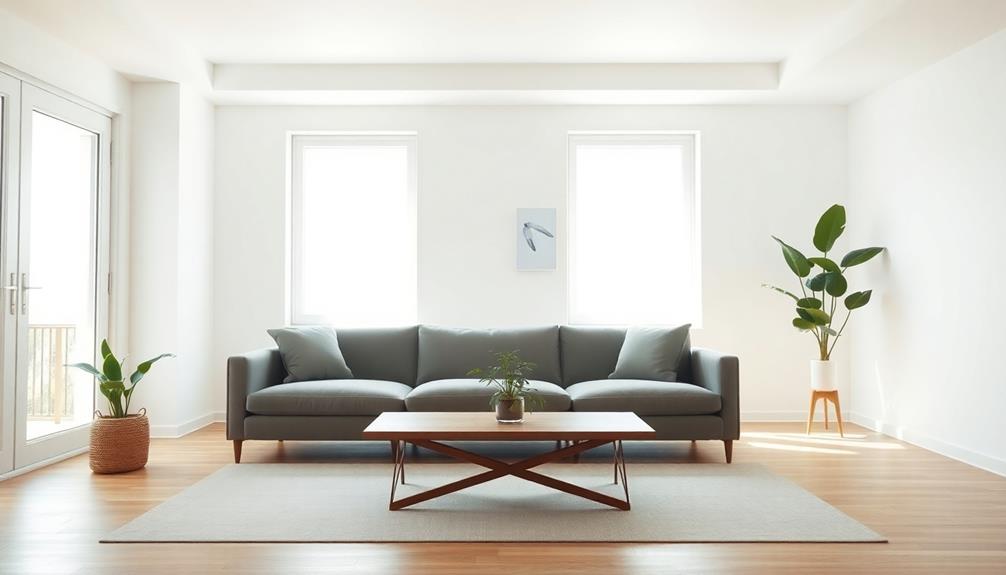
When you're choosing minimalist furniture, focus on quality over quantity to guarantee lasting durability.
Incorporating elements inspired by traditional Indonesian houses can enhance your minimalist aesthetic while maintaining cultural significance.
Look for multi-functional designs that serve more than one purpose, helping you keep your space clutter-free.
Essential Furniture Selection
Selecting minimalist furniture is all about finding pieces that embody simplicity and functionality.
You'll want to focus on essential elements that enhance your minimalist space while maintaining an open, airy feel. Here are some tips to guide your selection:
- Emphasize clean lines: Look for furniture pieces with low-profile designs that create a sense of openness.
- Prioritize multifunctional furniture: Consider items like sofas with hidden storage or coffee tables that can double as workspaces to keep clutter to a minimum.
- Choose quality over quantity: Invest in high-quality materials and durable construction, guaranteeing your pieces last and remain stylish.
- Stick to a limited color palette: Opt for neutrals—whites, grays, and beiges—to foster a cohesive and serene atmosphere that aligns with minimalist principles.
- Strategically place statement pieces: Confirm each item serves a distinct purpose, maintaining focus and avoiding overcrowding in your space.
Multi-Functional Design Features
In minimalist interiors, multi-functional design features can make all the difference in maximizing space and maintaining a clean aesthetic. Choosing multi-functional furniture allows you to reduce clutter while enhancing both functionality and style.
For instance, consider sofas with hidden storage or coffee tables that convert into dining surfaces; these pieces serve multiple purposes, which aligns perfectly with minimalist principles.
By incorporating items like ottomans that double as storage solutions or beds with under-bed drawers, you not only improve space efficiency but also create a streamlined environment.
Modular furniture adds another layer of versatility, letting you reconfigure your space to meet various needs without compromising on aesthetic appeal.
Opting for high-quality, durable materials in these multi-functional pieces guarantees longevity and sustainability, further supporting the minimalist ethos of valuing quality over quantity.
With thoughtful selections, you can transform your living space into a harmonious blend of practicality and elegance.
Embrace the power of multi-functional design features, and watch how they revolutionize your minimalist interior, making every square inch count while keeping your home beautifully organized.
Quality Over Quantity
Investing in quality over quantity is fundamental to achieving a truly minimalist interior. By selecting high-quality furniture pieces, you not only enhance the aesthetic of your space but also promote sustainability.
Fewer, well-crafted items create a cohesive look that highlights the beauty of each piece, ensuring your home feels inviting rather than cluttered.
When choosing minimalist furniture, consider these key elements:
- Durability: High-quality furniture lasts longer, reducing the need for replacements.
- Timeless appeal: Opt for designs that won't go out of style, aligning with minimalist values.
- Multi-functional furniture: Look for pieces like storage sofas or convertible coffee tables that maximize utility.
- Thoughtfully chosen statement pieces: Select items that add personality without overwhelming the space.
- Conscious consumption: Prioritize responsible manufacturing practices to minimize waste.
Incorporating Natural Elements

How can you transform a minimalist space into a warm and inviting haven? Start by incorporating natural elements that enhance both warmth and texture while keeping a clean aesthetic.
Wooden furniture is a fantastic choice; it adds character and creates a calming atmosphere, grounding your space.
Introduce plants like succulents and ferns to not only provide a pop of color but also improve indoor air quality. These green accents make your environment feel alive and connected to nature.
Additionally, maximize natural light by ensuring ample window space and using sheer curtains, which help create an airy environment that links the indoors with the outdoors.
Opt for textiles made from cotton, linen, or wool, promoting a sustainable design approach while adding comfort and simplicity to your decor.
Finally, consider using decor items with organic shapes, such as hand-carved wooden bowls or pebble-like sculptures. These pieces bring a sense of tranquility and organic flow, enriching your minimalist space.
Embracing these elements will help you cultivate a serene, inviting home where simplicity and nature coexist beautifully.
Personalizing Minimalist Interiors
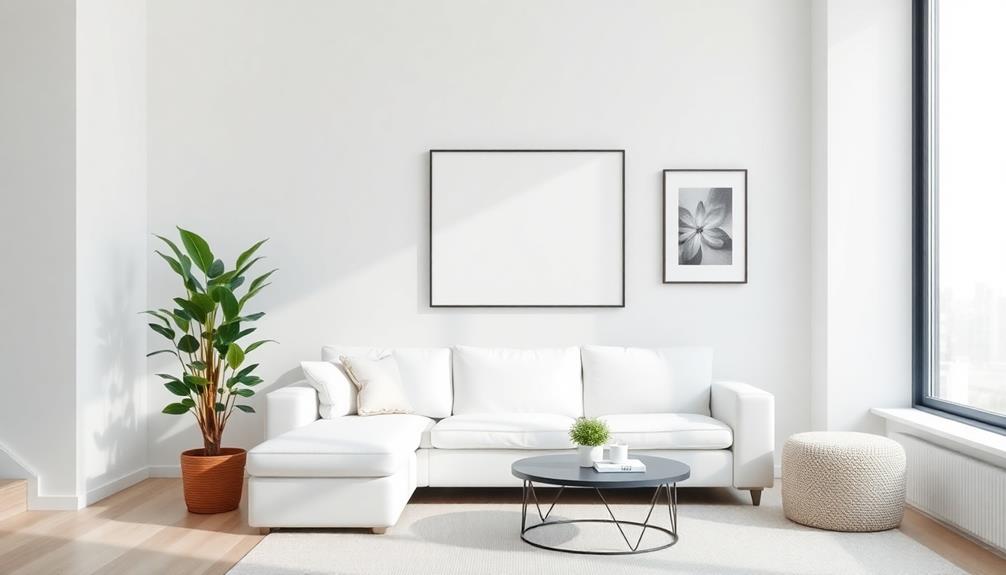
Personalizing minimalist interiors can transform a simple space into a reflection of your unique style and values. By carefully selecting meaningful decor items, you can enhance the aesthetic while maintaining the clean lines that define minimalism. This might involve incorporating a few statement pieces that hold sentimental value or adding pops of color through textiles or artwork. Achieving the perfect balance between simplicity and personalization is key to creating a minimalist space that feels like home. Additionally, choosing decor items that serve a dual purpose, such as a stylish storage solution, can help maintain the sleek and uncluttered feel of a minimalist interior.
Here are some ways to personalize your minimalist spaces:
- Choose statement pieces: A large artwork or unique furniture item can add character without overwhelming the room.
- Incorporate natural elements: Use plants or wooden accents to introduce warmth and texture, aligning with the principles of functionality and simplicity.
- Curate personal touches: Display family photographs or travel souvenirs thoughtfully, ensuring they evoke positive memories and harmonize with the overall decor.
- Emphasize negative space: Allow breathing room in your design to let individual items shine, creating a balanced environment.
- Select colors and textures mindfully: Stick to a cohesive palette that complements your personal style while keeping the space serene.
Frequently Asked Questions
Why Is Minimalist Interior Design so Popular?
Minimalist interior design's popularity stems from its ability to create serene, functional spaces that promote mental well-being. You'll appreciate its focus on sustainability and intentional living, allowing you to enjoy a clutter-free, calming environment.
What Is the Philosophy of Minimalist Interior Design?
The philosophy of minimalist interior design is all about simplicity. You focus on essential elements, decluttering your space, using neutral colors, and choosing multifunctional furniture, creating a calming environment that promotes clarity and mindfulness in your life.
What Is the Point of Minimalist Design?
So, you think filling your space with every knickknack brings joy? Minimalist design strips away clutter, letting you breathe and focus on what truly matters—your sanity, creativity, and a serene environment that calms your chaotic mind.
Who Invented Minimalist Interior Design?
You might think minimalist interior design emerged from various influences rather than a single inventor. Key figures like Ludwig Mies van der Rohe and architects from the Bauhaus school shaped its principles, emphasizing simplicity and functionality.
Conclusion
So, you're ready to embrace the power of minimalist decor, huh? Imagine a home so sparse that even dust bunnies feel like overcrowded guests. Less is more, right? You'll find joy in a single chair, dramatically placed, like a lone actor on an empty stage. Nature's your best friend; a single plant can be your "jungle." Personalize it with a single framed photo, because who needs memories cluttering up the vibe? Welcome to your chic, minimalist paradise!
